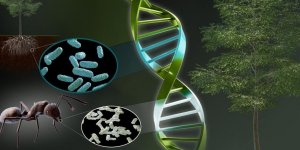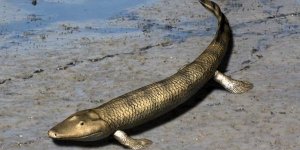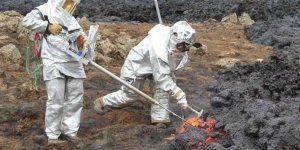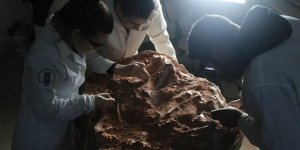Science News

Crystalline particles show high potential for hardening when deformed, revealing universal strength of interlocking defects. »

A team of scientists identified a gene in a poplar tree that enhances photosynthesis and can boost tree height by about 30% in the field and by as much as 200% in the greenhouse. »

Artificial intelligence can enhance medical imaging by detecting patterns beyond human perception, but a new study reveals the technology may produce highly accurate yet misleading results by relying on unintended data cues. »

Researchers have identified a molecule essential for the microbial conversion of less toxic inorganic mercury into the neurotoxin methylmercury, moving closer to blocking the dangerous pollutant before it forms. »

A ‘one of a kind’ fossil discovery could transform our understanding of how the unique brains and intelligence of modern birds evolved, one of the most enduring mysteries of vertebrate evolution. »

A researcher developed a machine learning model that uses data stored in paleoclimate archives, such as tree rings, to investigate how shifts in climate impact atmospheric blocking, a weather phenomenon linked to heat waves, cold spells and unusual rainfall events. »

A team of paleontologists recently discovered that an ancient seascape known for its diverse assemblage of exceptionally preserved fossils represents an unexpected oceanic setting, placing the fossils in an environmental context that is dramatically different from other fossil assemblages of the Cambrian age. »

On an airplane, motions of the air on both small and large scales contribute to turbulence, which may result in a bumpy flight. Turbulence on a much larger scale is important to how stars form in giant molecular clouds that permeate the Milky Way. »

The transition from water to land is one of the most significant events in the history of life on Earth. »

Researchers at Penn State University suggest that Earth’s only satellite may have come from a “binary-exchange capture” rather than a planetary collision, challenging conventional ideas on lunar origins. »

Native wild bees native play a critical role in ecosystems, pollinating countless plant species, including agricultural crops. »

An avulsion is a river term referring to the rapid abandonment of a channel and the formation of a new one, often resulting in devastating flooding. »

How plants balance carbon dioxide intake with water loss in the face of rising temperatures has implications for water use in agriculture and the resilience of critical crops to environmental change. »

In a new study, a team researchers suggests that 4 billion years ago, plate tectonics likely looked closer to what we experience today than previously thought. »

Discovery of regenerative process could aid in treating human gastrointestinal diseases »

U.S. National Science Foundation-funded researchers recently found a fossil that led to the discovery of a brand-new dinosaur species, Lokiceratops rangiformis. »

Researchers at Columbia University's Department of Earth and Environment Science have discovered new implications for the Arctic carbon cycle in the face of climate change. »

Researchers have used the chemical fingerprints of zinc contained in meteorites to determine the origin of volatile elements on Earth »

Researchers have discovered that seabirds, including penguins and albatrosses, have highly-sensitive regions in their beaks that could be used to help them find food. This is the first time this ability has been identified in seabirds. »

Permafrost is permanently frozen soil in the coldest areas of the planet. »

Scientists have discovered a new species of tiny microbes in an extremely inhospitable lake, which form large colonies and interact with other microbes in unique ways. »

Once upon a time, the Teton Range, a 40-mile-long mountain range in the northern Rocky Mountains, may have extended much longer than it does now. »

A research team at the Virginia Institute of Marine Science at William & Mary has uncovered a new species of Antarctic fish, which could reshape how scientists view biodiversity in the Southern Ocean. »

A new study from Cornell University has uncovered a mechanism in the brain that allows for memory resetting during sleep, ensuring continuous learning without overloading the brain's capacity. »

A recent study has provided new insights into the origin of the asteroid that caused the mass extinction event 66 million years ago, confirming it formed beyond Jupiter's orbit and debunking the theory that it was a comet. »

New research using two decades worth of data could change how scientists think about bird migrations and the interdependencies and relationships they involve. »

U.S. Department of Agriculture (USDA)’s Agricultural Research Service (ARS) scientists developed a high quality and inexpensive pectin that can successfully gel in low sugar products and still be scalable for commercial production. »

Researchers have identified an entirely new type of wood that does not fit into either category of hardwood or softwood. »

Scientists have determined that a rare element found in some of the oldest solids in the solar system, such as meteorites, and previously thought to have been forged in supernova explosions, actually predate such cosmic events, challenging long-held theories about its origin. »

A new study reveals that high levels of artificial light at night result in tougher leaves on urban trees, making them less palatable to insects and potentially disrupting urban food chains. »

A team of researchers has discovered that an Iceland volcano changed how it formed magma as it continued to erupt from 2021 to 2022. »

Distant relatives across the plant kingdom use similar genetic tools to grow, and lose, thorns »

New study proposes a framework for “Child Safe AI” following recent incidents which revealed that many children see chatbots as quasi-human and trustworthy. »

It looks like a cherry tomato wrapped in a paper lantern, but in fact it's called a groundcherry. Little-known beyond gardeners and farmers, the groundcherry has quietly produced fruit across North America for centuries. »

The central and eastern regions of the United States are the hotspots for Earth's most damaging and frequent tornadoes, scientists have found. »

Cambridge scientists have developed an artificially-intelligent tool capable of predicting in four cases out of five whether people with early signs of dementia will remain stable or develop Alzheimer’s disease. »

Minutes after lightning lit the dark evening sky in the middle of a blizzard, a team of seven students and researchers rapidly unzipped a bright yellow bag the size of a small car to release a giant white balloon. »

New gene editing technique lowers cost and shortens time to make desired varieties »

Blue and great tits deploy surprisingly powerful memories to find food, a new study finds. »

Researchers from the Paleontological Research Support Center of Quarta Colônia, at the Federal University of Santa Maria, in Rio Grande do Sul state, have made a momentous discovery for world paleontology in the municipality of São João do Polêsine, in the central region of the state. »

A team led by researchers from Duke-NUS Medical School in Singapore and Imperial College London conducted a study on mice, revealing that blocking a protein known as interleukin-11 (IL-11) extended the animals' lifespan and prevented age-related health issues. »

Researchers used quantum simulations to obtain new insights into the nature of neutrinos — the mysterious subatomic particles that abound throughout the universe — and their role in the deaths of massive stars. »

Breakthrough provides a new method for studying the history of life on Earth. »

The United States Department of Agriculture (USDA)’s Agricultural Research Service (ARS) and University of Georgia College of Agricultural and Environmental Sciences researchers studied the impact of pearl millet as a source of insect food by surveying insects collecting and consuming the sucrose-rich pollen of this crop. »

Spectroscopy and electronic simulations on supercomputers reveal evolution of reactive chemical species »

Findings reveal potential for new measurement technology so accurate it might determine if some fundamental properties of nature are changing. »

The process, developed by Brazilian and Spanish scientists, obtains anthocyanin from fruit processing waste with a higher yield than the usual method. »

New research by scientists making use of U.S. National Science Foundation facilities has provided insight into how related ocean creatures have adapted to live in vastly different environments. »

The ultracold, exotic form of matter had previously been achieved only with atoms of a single element, such as rubidium »
